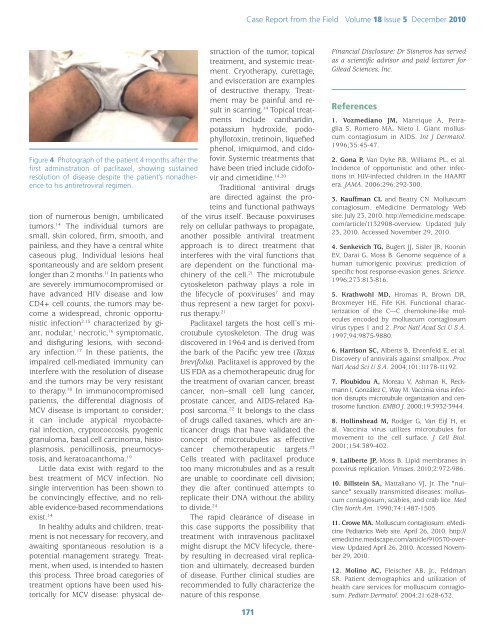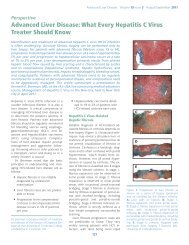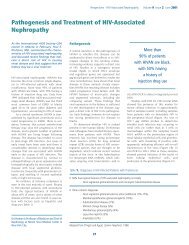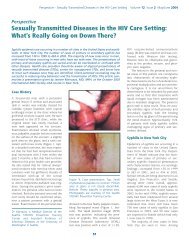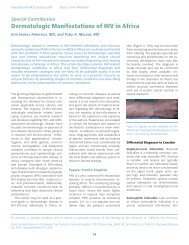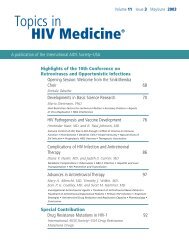Recalcitrant Giant Molluscum Contagiosum in a Patient With ...
Recalcitrant Giant Molluscum Contagiosum in a Patient With ...
Recalcitrant Giant Molluscum Contagiosum in a Patient With ...
- No tags were found...
Create successful ePaper yourself
Turn your PDF publications into a flip-book with our unique Google optimized e-Paper software.
Case Report from the Field Volume 18 Issue 5 December 2010Figure 4. Photograph of the patient 4 months after thefirst adm<strong>in</strong>istration of paclitaxel, show<strong>in</strong>g susta<strong>in</strong>edresolution of disease despite the patient’s nonadherenceto his antiretroviral regimen.tion of numerous benign, umbilicatedtumors. 14 The <strong>in</strong>dividual tumors aresmall, sk<strong>in</strong> colored, firm, smooth, andpa<strong>in</strong>less, and they have a central whitecaseous plug. Individual lesions healspontaneously and are seldom presentlonger than 2 months. 11 In patients whoare severely immumocompromised orhave advanced HIV disease and lowCD4+ cell counts, the tumors may becomea widespread, chronic opportunistic<strong>in</strong>fection 2,15 characterized by giant,nodular, 1 necrotic, 16 symptomatic,and disfigur<strong>in</strong>g lesions, with secondary<strong>in</strong>fection. 17 In these patients, theimpaired cell-mediated immunity can<strong>in</strong>terfere with the resolution of diseaseand the tumors may be very resistantto therapy. 18 In immunocompromisedpatients, the differential diagnosis ofMCV disease is important to consider;it can <strong>in</strong>clude atypical mycobacterial<strong>in</strong>fection, cryptococcosis, pyogenicgranuloma, basal cell carc<strong>in</strong>oma, histoplasmosis,penicill<strong>in</strong>osis, pneumocystosis,and keratoacanthoma. 19Little data exist with regard to thebest treatment of MCV <strong>in</strong>fection. Nos<strong>in</strong>gle <strong>in</strong>tervention has been shown tobe conv<strong>in</strong>c<strong>in</strong>gly effective, and no reliableevidence-based recommendationsexist. 14In healthy adults and children, treatmentis not necessary for recovery, andawait<strong>in</strong>g spontaneous resolution is apotential management strategy. Treatment,when used, is <strong>in</strong>tended to hastenthis process. Three broad categories oftreatment options have been used historicallyfor MCV disease: physical destructionof the tumor, topicaltreatment, and systemic treatment.Cryotherapy, curettage,and evisceration are examplesof destructive therapy. Treatmentmay be pa<strong>in</strong>ful and result<strong>in</strong> scarr<strong>in</strong>g. 14 Topical treatments<strong>in</strong>clude cantharid<strong>in</strong>,potassium hydroxide, podophyllotox<strong>in</strong>,tret<strong>in</strong>o<strong>in</strong>, liquefiedphenol, imiquimod, and cidofovir.Systemic treatments thathave been tried <strong>in</strong>clude cidofovirand cimetid<strong>in</strong>e. 14,20Traditional antiviral drugsare directed aga<strong>in</strong>st the prote<strong>in</strong>sand functional pathwaysof the virus itself. Because poxvirusesrely on cellular pathways to propagate,another possible antiviral treatmentapproach is to direct treatment that<strong>in</strong>terferes with the viral functions thatare dependent on the functional mach<strong>in</strong>eryof the cell. 21 The microtubulecytoskeleton pathway plays a role <strong>in</strong>the lifecycle of poxviruses 7 and maythus represent a new target for poxvirustherapy. 21Paclitaxel targets the host cell’s microtubulecytoskeleton. The drug wasdiscovered <strong>in</strong> 1964 and is derived fromthe bark of the Pacific yew tree (Taxusbrevifolia). Paclitaxel is approved by theUS FDA as a chemotherapeutic drug forthe treatment of ovarian cancer, breastcancer, non–small cell lung cancer,prostate cancer, and AIDS-related Kaposisarcoma. 22 It belongs to the classof drugs called taxanes, which are anticancerdrugs that have validated theconcept of microtubules as effectivecancer chemotherapeutic targets. 23Cells treated with paclitaxel producetoo many microtubules and as a resultare unable to coord<strong>in</strong>ate cell division;they die after cont<strong>in</strong>ued attempts toreplicate their DNA without the abilityto divide. 24The rapid clearance of disease <strong>in</strong>this case supports the possibility thattreatment with <strong>in</strong>travenous paclitaxelmight disrupt the MCV lifecycle, therebyresult<strong>in</strong>g <strong>in</strong> decreased viral replicationand ultimately, decreased burdenof disease. Further cl<strong>in</strong>ical studies arerecommended to fully characterize thenature of this response.F<strong>in</strong>ancial Disclosure: Dr Sisneros has servedas a scientific advisor and paid lecturer forGilead Sciences, Inc.References1. Vozmediano JM, Manrique A, PetragliaS, Romero MA, Nieto I. <strong>Giant</strong> molluscumcontagiosum <strong>in</strong> AIDS. Int J Dermatol.1996;35:45-47.2. Gona P, Van Dyke RB, Williams PL, et al.Incidence of opportunistic and other <strong>in</strong>fections<strong>in</strong> HIV-<strong>in</strong>fected children <strong>in</strong> the HAARTera. JAMA. 2006;296:292-300.3. Kauffman CL and Beatty CN. <strong>Molluscum</strong>contagiosum. eMedic<strong>in</strong>e Dermatology Website. July 23, 2010. http://emedic<strong>in</strong>e.medscape.com/article/1132908-overview. Updated July23, 2010. Accessed November 29, 2010.4. Senkevich TG, Bugert JJ, Sisler JR, Koon<strong>in</strong>EV, Darai G, Moss B. Genome sequence of ahuman tumorigenic poxvirus: prediction ofspecific host response-evasion genes. Science.1996;273:813-816.5. Krathwohl MD, Hromas R, Brown DR,Broxmeyer HE, Fife KH. Functional characterizationof the C---C chemok<strong>in</strong>e-like moleculesencoded by molluscum contagiosumvirus types 1 and 2. Proc Natl Acad Sci U S A.1997;94:9875-9880.6. Harrison SC, Alberts B, Ehrenfeld E, et al.Discovery of antivirals aga<strong>in</strong>st smallpox. ProcNatl Acad Sci U S A. 2004;101:11178-11192.7. Ploubidou A, Moreau V, Ashman K, ReckmannI, González C, Way M. Vacc<strong>in</strong>ia virus <strong>in</strong>fectiondisrupts microtubule organization and centrosomefunction. EMBO J. 2000;19:3932-3944.8. Holl<strong>in</strong>shead M, Rodger G, Van Eijl H, etal. Vacc<strong>in</strong>ia virus utilizes microtubules formovement to the cell surface. J Cell Biol.2001;154:389-402.9. Laliberte JP, Moss B. Lipid membranes <strong>in</strong>poxvirus replication. Viruses. 2010;2:972-986.10. Billste<strong>in</strong> SA, Mattaliano VJ, Jr. The "nuisance"sexually transmitted diseases: molluscumcontagiosum, scabies, and crab lice. MedCl<strong>in</strong> North Am. 1990;74:1487-1505.11. Crowe MA. <strong>Molluscum</strong> contagiosum. eMedic<strong>in</strong>ePediatrics Web site. April 26, 2010. http://emedic<strong>in</strong>e.medscape.com/article/910570-overview.Updated April 26, 2010. Accessed November29, 2010.12. Mol<strong>in</strong>o AC, Fleischer AB, Jr., FeldmanSR. <strong>Patient</strong> demographics and utilization ofhealth care services for molluscum contagiosum.Pediatr Dermatol. 2004;21:628-632.171


